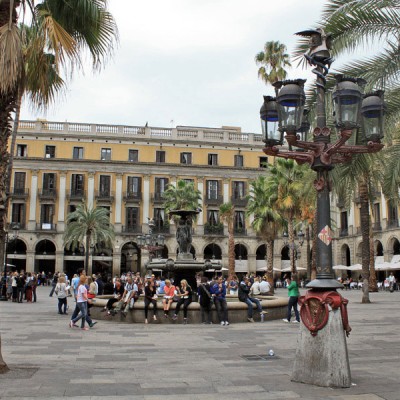Reial
Plaça Reial
Built on the site of the former convent of the Capuchins, built in 1718 and demolished in 1848. It was so named because Isabel II laid the first stone of what was to be a monument to Ferdinand.
One of the most bustling and vital squares in Barcelona, especially at night
The elegant ambiance of the Plaça Reial is accentuated by the fountain, streetlamps and palm trees, and it is one of Barcelona's busiest, most vibrant spots, particularly at night. This is Barcelona's best-loved porticoed square.
In about 1835, many of Barcelona's religious buildings disappeared as a result of the confiscation of properties. This was the case with the former Capuchin convent which was demolished leaving a huge vacant plot behind. The current Plaça Reial was built a few years later. The architect was Francesc Molina, and he designed a luxurious square with the aim of extolling the monarchy. King Ferdinand VII, who was king at the time, was to be immortalised as a statue depicting him on horseback in the centre of the square. The monument never came to fruition and, in its place, stands the fountain of the Three Graces. The two streetlamps on both sides of the central fountain were designed by the young Antoni Gaudí. Surmounted by a winged helmet and a dragon, they were put in place in 1879. Around them, the royal palm trees grace the square lending it an exotic touch. There are uniform, noble buildings on every side with porticoes and terracotta decorations. They were the home of important Barcelona families, although this luxurious appearance has been somewhat toned down by a more bohemian atmosphere.
Today, the square is a busy nightlife hub, and the porticoes conceal restaurants, bars and some of Barcelona's most popular nightspots.















